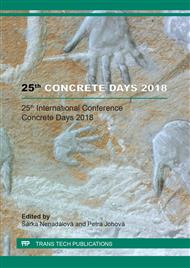[1]
Butt, A. A., Mirzadeh, I., Toller, S., & Birgisson, B. (2014). Life cycle assessment framework for asphalt pavements: methods to calculate and allocate energy of binder and additives. International Journal of Pavement Engineering, 15(4), 290-302.
DOI: 10.1080/10298436.2012.718348
Google Scholar
[2]
Ong, H. C., Mahlia, T. M. I., & Masjuki, H. H. (2011). A review on emissions and mitigation strategies for road transport in Malaysia. Renewable and Sustainable Energy Reviews, 15(8), 3516-3522.
DOI: 10.1016/j.rser.2011.05.006
Google Scholar
[3]
Pigeon, M., & Pleau, R. (2010). Durability of concrete in cold climates. CRC Press.
Google Scholar
[4]
Alhassan, M. M. (2015). Impact on Quality and Productivity of Using Technological Advances in Road Construction Industry(Doctoral dissertation, Sudan University of Science and Technology).
Google Scholar
[5]
Scheving, A. G. (2011). Life cycle cost analysis of asphalt and concrete pavements. Reykjavík University.
Google Scholar
[6]
Lee, K. W., & Kohm, S. (2014). Cool Pavements. In Climate Change, Energy, Sustainability and Pavements (pp.439-453). Springer Berlin Heidelberg.
DOI: 10.1007/978-3-662-44719-2_16
Google Scholar
[7]
Abtahi, S. M., Sheikhzadeh, M., & Hejazi, S. M. (2010). Fiber-reinforced asphalt-concrete–a review. Construction and Building Materials, 24(6), 871-877.
DOI: 10.1016/j.conbuildmat.2009.11.009
Google Scholar
[8]
Mosaberpanah, M. A., & Eren, O. (2016). CO2-full factorial optimization of an ultra-high performance concrete mix design. European Journal of Environmental and Civil Engineering, 1-14.
DOI: 10.1080/19648189.2016.1210030
Google Scholar
[9]
Mosaberpanah, M. A., & Eren, O. (2016). Relationship between 28-days compressive strength and Compression toughness factor of Ultra High Performance Concrete using design of experiments. Procedia Engineering, 145, 1565-1571.
DOI: 10.1016/j.proeng.2016.04.197
Google Scholar
[10]
Jang, H. O., Lee, H. S., Cho, K., & Kim, J. (2017). Experimental study on shear performance of plain construction joints integrated with ultra-high performance concrete (UHPC). Construction and Building Materials, 152, 16-23.
DOI: 10.1016/j.conbuildmat.2017.06.156
Google Scholar
[11]
Jiang, X., Yuan, Y., Wu, C., & Luo, C. (2017). Fatigue life assessment of orthotropic steel deck with UHPC pavement. Journal of Engineering, (2017).
DOI: 10.1155/2017/8413607
Google Scholar
[12]
Hadl, P., della Pietra, R., Hoang, K. H., Pilch, E., & Tue, N. V. (2015). Application of UHPC as road bridge topping within the adaptation of an existing conventional bridge to an integral abutment bridge in Austria. BETON-UND STAHLBETONBAU, 110(2), 162-170.
DOI: 10.1002/best.201400091
Google Scholar
[13]
Mosaberpanah, M. A., & Eren, O. (2017). Effect of quartz powder, quartz sand and water curing regimes on mechanical properties of UHPC using response surface modelling. ADVANCES IN CONCRETE CONSTRUCTION, 5(5), 481-492.
Google Scholar


